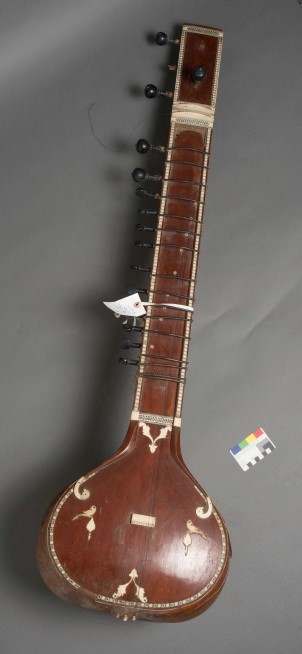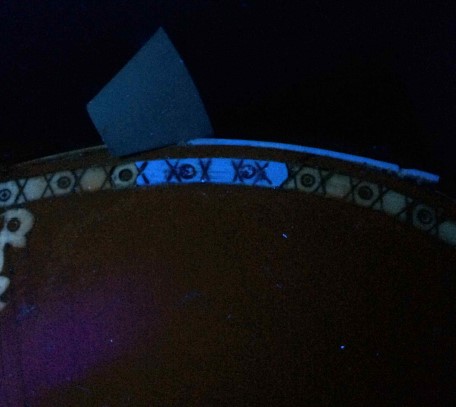September ’21
Sitar

The object is a sitar, an instrument popular in Indian classical music since the late 19th century, and is part of the Oriental Museum collections. It is constructed of a gourd belly with a wood body. 11 sympathetic strings run under the brass frets and 7 played strings run over the frets, raised above the body. These are tightened with painted wooden pegs, and create the characteristic sound of the sitar.

The sitar as we know it today evolved out of a mix of Persian and Hindustani (North Indian) instruments and musical styles of the Mughal and provincial courts, where music was of the utmost importance. Following the development of the sitar, it has become associated with religion, and was also used to accompany dancers as well as other instruments to create lyrical music for entertainment.
Following the fall of the British Raj in 1947, sitar music saw a surge in popularity in the West. Though many skilled musicians had a hand in this, the meteoric rise to Western fame is predominantly credited to Ravi Shankar and Vilayat Khan – those whose names adorn the two main styles of instrument. The sitar entered Western pop culture through use by the likes of The Beatles and The Rolling Stones. It has remained a popular and beautiful staple in music since and provides a link between East and West, past and present.
Condition
- Dirt is visible on the surface of the sitar
- The frets of the sitar are tarnished
- Areas of inlay are missing, several other areas are laminating
- There are signs of mould growth on the gourd
- The sitar strings are corroded, damaged, or missing
- Several of the pegs are damaged
- There is a missing tar jawari
Conservation

The initial surface dirt was removed using smokesponge as this successfully removed the dirt without damaging the surface of the sitar. This treatment was ineffective at removing the mould and so a solution of 70:30 ethanol / deionised water was applied using cotton wool swabs to kill and remove the mould spores.
The tarnish on the brass frets was removed using a very fine grade wire wool with a suitable lubricant. This was successful at removing the tarnish, while also ensuring the surface wasn’t damaged from the treatment.

An attempt was made at replacing the damaged pegs by moulding and casting the remaining ones. However this was unsuccessful and the decision was made that they would not have been strong enough to tighten the strings. As such, new wooden pegs were created by turning on a lathe. They were then colour matched to the original pegs using acrylics and were set in place of the damaged pegs.

The laminating areas of inlay were small and focussed around bends in the gourd where extra stress was placed on the internal structure of the celluloid. To stabilise these areas, an appropriate consolidant was applied in layers. New inlay pieces were cut out of Elforyn ivory alternative using a Dremel. Elforyn is a synthetic polymer made to mimic ivory, which fluoresces under UV light making it easily identifiable from the original celluloid. The missing bridge (tar jawari) was also made from a piece of Elforyn with a wooden base. All replica pieces were secured in place using a suitable adhesive.
Initially, an attempt was made to retain the original strings by applying a fine netting over the top of the fretboard and sewing the strings in place. However this was unsuccessful and as it was determined that the strings were badly corroded and may be damaged further if they remained in situ, the decision was made to replace them and restring the sitar, while still retaining the original strings separately.
As sitars are traditionally varnished, the decision was made to apply a varnish to the Oriental Museum sitar. Mylands Heat Resistant Polish was chosen as it would mimic a traditional varnish while remaining long term stable. It was applied using a small amount of ethanol as a thinner and a medium sized paint brush to ensure even strokes. The end result was an attractive sheen.
Stay tuned for next month’s object!
